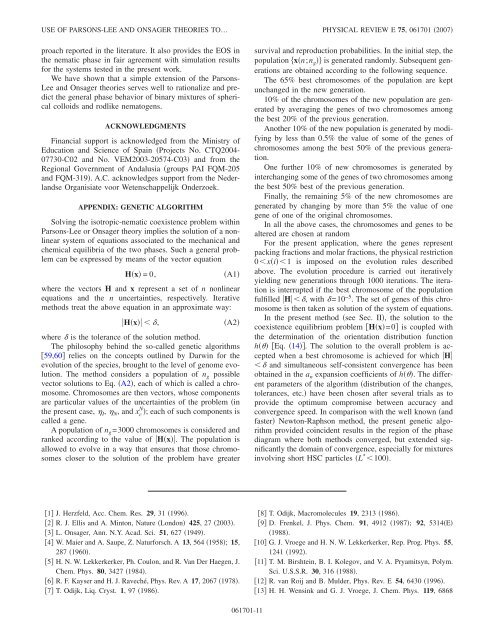Use of Parsons-Lee and Onsager theories to - APS Link Manager ...
Use of Parsons-Lee and Onsager theories to - APS Link Manager ...
Use of Parsons-Lee and Onsager theories to - APS Link Manager ...
You also want an ePaper? Increase the reach of your titles
YUMPU automatically turns print PDFs into web optimized ePapers that Google loves.
USE OF PARSONS-LEE AND ONSAGER THEORIES TO…proach reported in the literature. It also provides the EOS inthe nematic phase in fair agreement with simulation resultsfor the systems tested in the present work.We have shown that a simple extension <strong>of</strong> the <strong>Parsons</strong>-<strong>Lee</strong> <strong>and</strong> <strong>Onsager</strong> <strong>theories</strong> serves well <strong>to</strong> rationalize <strong>and</strong> predictthe general phase behavior <strong>of</strong> binary mixtures <strong>of</strong> sphericalcolloids <strong>and</strong> rodlike nema<strong>to</strong>gens.ACKNOWLEDGMENTSFinancial support is acknowledged from the Ministry <strong>of</strong>Education <strong>and</strong> Science <strong>of</strong> Spain Projects No. CTQ2004-07730-C02 <strong>and</strong> No. VEM2003-20574-C03 <strong>and</strong> from theRegional Government <strong>of</strong> Andalusia groups PAI FQM-205<strong>and</strong> FQM-319. A.C. acknowledges support from the Nederl<strong>and</strong>seOrganisiate voor Wetenschappelijk Onderzoek.APPENDIX: GENETIC ALGORITHMSolving the isotropic-nematic coexistence problem within<strong>Parsons</strong>-<strong>Lee</strong> or <strong>Onsager</strong> theory implies the solution <strong>of</strong> a nonlinearsystem <strong>of</strong> equations associated <strong>to</strong> the mechanical <strong>and</strong>chemical equilibria <strong>of</strong> the two phases. Such a general problemcan be expressed by means <strong>of</strong> the vec<strong>to</strong>r equationHx =0,A1where the vec<strong>to</strong>rs H <strong>and</strong> x represent a set <strong>of</strong> n nonlinearequations <strong>and</strong> the n uncertainties, respectively. Iterativemethods treat the above equation in an approximate way:Hx ,A2where is the <strong>to</strong>lerance <strong>of</strong> the solution method.The philosophy behind the so-called genetic algorithms59,60 relies on the concepts outlined by Darwin for theevolution <strong>of</strong> the species, brought <strong>to</strong> the level <strong>of</strong> genome evolution.The method considers a population <strong>of</strong> n g possiblevec<strong>to</strong>r solutions <strong>to</strong> Eq. A2, each <strong>of</strong> which is called a chromosome.Chromosomes are then vec<strong>to</strong>rs, whose componentsare particular values <strong>of</strong> the uncertainties <strong>of</strong> the problem inthe present case, I , N , <strong>and</strong> x c N ; each <strong>of</strong> such components iscalled a gene.A population <strong>of</strong> n g =3000 chromosomes is considered <strong>and</strong>ranked according <strong>to</strong> the value <strong>of</strong> Hx. The population isallowed <strong>to</strong> evolve in a way that ensures that those chromosomescloser <strong>to</strong> the solution <strong>of</strong> the problem have greaterPHYSICAL REVIEW E 75, 061701 2007survival <strong>and</strong> reproduction probabilities. In the initial step, thepopulation xn;n g is generated r<strong>and</strong>omly. Subsequent generationsare obtained according <strong>to</strong> the following sequence.The 65% best chromosomes <strong>of</strong> the population are keptunchanged in the new generation.10% <strong>of</strong> the chromosomes <strong>of</strong> the new population are generatedby averaging the genes <strong>of</strong> two chromosomes amongthe best 20% <strong>of</strong> the previous generation.Another 10% <strong>of</strong> the new population is generated by modifyingby less than 0.5% the value <strong>of</strong> some <strong>of</strong> the genes <strong>of</strong>chromosomes among the best 50% <strong>of</strong> the previous generation.One further 10% <strong>of</strong> new chromosomes is generated byinterchanging some <strong>of</strong> the genes <strong>of</strong> two chromosomes amongthe best 50% best <strong>of</strong> the previous generation.Finally, the remaining 5% <strong>of</strong> the new chromosomes aregenerated by changing by more than 5% the value <strong>of</strong> onegene <strong>of</strong> one <strong>of</strong> the original chromosomes.In all the above cases, the chromosomes <strong>and</strong> genes <strong>to</strong> bealtered are chosen at r<strong>and</strong>omFor the present application, where the genes representpacking fractions <strong>and</strong> molar fractions, the physical restriction0xi1 is imposed on the evolution rules describedabove. The evolution procedure is carried out iterativelyyielding new generations through 1000 iterations. The iterationis interrupted if the best chromosome <strong>of</strong> the populationfulfilled H, with =10 −5 . The set <strong>of</strong> genes <strong>of</strong> this chromosomeis then taken as solution <strong>of</strong> the system <strong>of</strong> equations.In the present method see Sec. II, the solution <strong>to</strong> thecoexistence equilibrium problem Hx=0 is coupled withthe determination <strong>of</strong> the orientation distribution functionh Eq. 14. The solution <strong>to</strong> the overall problem is acceptedwhen a best chromosome is achieved for which H <strong>and</strong> simultaneous self-consistent convergence has beenobtained in the a n expansion coefficients <strong>of</strong> h. The differentparameters <strong>of</strong> the algorithm distribution <strong>of</strong> the changes,<strong>to</strong>lerances, etc. have been chosen after several trials as <strong>to</strong>provide the optimum compromise between accuracy <strong>and</strong>convergence speed. In comparison with the well known <strong>and</strong>faster New<strong>to</strong>n-Raphson method, the present genetic algorithmprovided coincident results in the region <strong>of</strong> the phasediagram where both methods converged, but extended significantlythe domain <strong>of</strong> convergence, especially for mixturesinvolving short HSC particles L * 100.1 J. Herzfeld, Acc. Chem. Res. 29, 311996.2 R. J. Ellis <strong>and</strong> A. Min<strong>to</strong>n, Nature London 425, 272003.3 L. <strong>Onsager</strong>, Ann. N.Y. Acad. Sci. 51, 627 1949.4 W. Maier <strong>and</strong> A. Saupe, Z. Naturforsch. A 13, 564 1958; 15,287 1960.5 H. N. W. Lekkerkerker, Ph. Coulon, <strong>and</strong> R. Van Der Haegen, J.Chem. Phys. 80, 3427 1984.6 R. F. Kayser <strong>and</strong> H. J. Raveché, Phys. Rev. A 17, 2067 1978.7 T. Odijk, Liq. Cryst. 1, 971986.8 T. Odijk, Macromolecules 19, 2313 1986.9 D. Frenkel, J. Phys. Chem. 91, 4912 1987; 92, 5314E1988.10 G. J. Vroege <strong>and</strong> H. N. W. Lekkerkerker, Rep. Prog. Phys. 55,1241 1992.11 T. M. Birshtein, B. I. Kolegov, <strong>and</strong> V. A. Pryamitsyn, Polym.Sci. U.S.S.R. 30, 316 1988.12 R. van Roij <strong>and</strong> B. Mulder, Phys. Rev. E 54, 6430 1996.13 H. H. Wensink <strong>and</strong> G. J. Vroege, J. Chem. Phys. 119, 6868061701-11
















